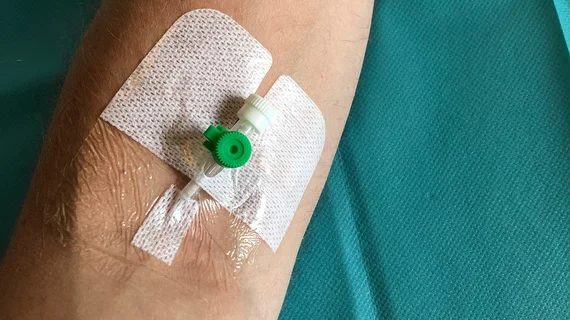Guidelines produce sizable drop in PICC line use, with radiologists leading the way
New evidence-based guidelines have helped dramatically drop the use of peripherally inserted central catheters, with interventional radiologists leading the way.
It was back in 2015 that Michigan Medicine first published its recommendations, outlining more restrictive use of PICC lines, particularly by physicians. While they’re a widely used and essential method for venous access, they can lead to major complications such as bloodstream infections and deep vein thrombosis, experts noted Wednesday.
But providers have made great strides in tackling this trend in the last 10 years. PICC placement in the U.S. has plummeted almost 50% since 2010, and the trend accelerated in 2015 following publication of the Michigan Appropriateness Guide for Intravenous Catheters.
“The implementation of the MAGIC guidelines has been shown to decrease PICC placement on an individual institutional level, and the findings of this study demonstrate a sharper decline in physician and [advanced practice provider] placement for Medicare enrollees following the 2015 publication,” Will Lindquester, MD, an interventional radiology resident with the University of Pittsburgh Medical Center, and colleagues wrote Aug. 26 in AJR. “This decrease in volume is appropriate given the large number of inappropriate scenarios for PICC placement discussed in MAGIC, with the desired result of decreasing PICC-related infections and complications.”
Lindquester et al. made their determinations by analyzing Medicare Part B claims logged between 2010 and 2018. They discovered that volume of such procedures dropped by 46.5% during that time span, down to 130,361 in the final year. The slope of the decrease went from 3.4 per provider before 2015 up to 7.3 after the guideline were published. And the change in slope was more pronounced for radiologists—going from 3.1 to 5.6 after 2015—when compared to advanced practice providers (0.01.9 versus 1.1). Professional payment per procedure also decreased for physicians from $78.04 to $70.17 by the end of the study period, with a similar dip for APPs.
The authors noted that the decline in PICC placement by interventional radiologists—typically performed under ultrasound and fluoroscopic guidance—likely occurred because MAGIC mentions limited scenarios that require a doc.
“Further study of changes in case complexity for interventional radiologists, given decrease volume of PICC placement by physicians, is warranted, especially in light of declining reimbursement for PICC placement,” the authors noted.
Read more in the American Journal of Roentgenology here.

